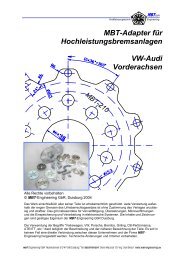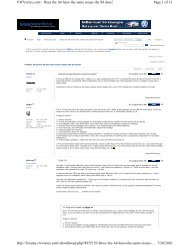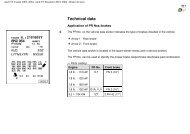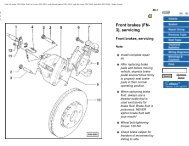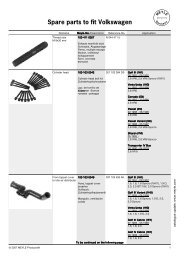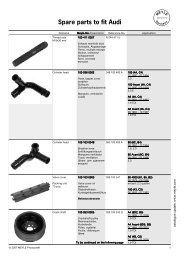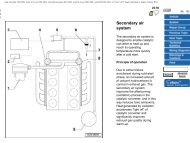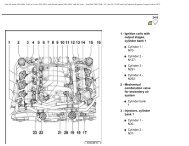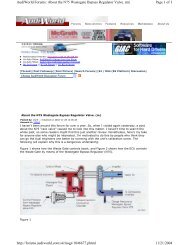VW MKII A2 MK2 Golf Jetta Fox Service Manual - VAGLinks.com
VW MKII A2 MK2 Golf Jetta Fox Service Manual - VAGLinks.com
VW MKII A2 MK2 Golf Jetta Fox Service Manual - VAGLinks.com
Create successful ePaper yourself
Turn your PDF publications into a flip-book with our unique Google optimized e-Paper software.
11 Cylinder head - dismantling<br />
and overhaul 3<br />
Dismantling<br />
1 Remove the cylinder head and camshaft, as<br />
described in the previous Sections.<br />
2 Using a valve spring <strong>com</strong>pressor, <strong>com</strong>press<br />
each valve spring in turn until the split collets<br />
can be removed. Release the <strong>com</strong>pressor and<br />
remove the retainers and springs (see<br />
illustrations). If the retainers are difficult to<br />
remove, do not continue to tighten the<br />
<strong>com</strong>pressor but gently tap the top of the tool<br />
with a hammer. Always make sure that the<br />
<strong>com</strong>pressor is held firmly over the retainer.<br />
3 Remove each valve from the cylinder head,<br />
keeping them identified for location.<br />
4 Prise the valve seals from the valve guides<br />
and remove the lower spring seats (see<br />
illustration).<br />
5 Do not remove the cam follower ball-studs<br />
unless they are unserviceable. They are likely<br />
to be seized in the head.<br />
Overhaul<br />
6 Use a scraper to carefully remove any<br />
carbon from the cylinder head. Remove all<br />
traces of gasket then wash the cylinder head<br />
thoroughly in paraffin and wipe dry.<br />
7 Use a straight-edge and feeler blade to<br />
check that the cylinder head mating surface is<br />
not distorted. If it is, then it must be<br />
resurfaced by a suitably equipped engineering<br />
works. If the cylinder head face is to be<br />
resurfaced, this will necessitate the valve<br />
seats being re-cut so that they are recessed<br />
deeper by an equivalent amount to that<br />
machined from the cylinder head. This is<br />
necessary to avoid the possibility of the valves<br />
<strong>com</strong>ing into contact with the pistons and<br />
causing serious damage and is a task to be<br />
entrusted to a suitably equipped engine<br />
recondition specialist. (see illustration).<br />
Engine repair procedures - 1.05 and 1.3 litre pre August 1985 2A•9<br />
11.2a Compressing a valve spring to remove split collets 11.2b Removing valve springs and retainers . . .<br />
8 Examine the valve heads for pitting and<br />
burning. Renew any valve which is badly<br />
burnt. Examine the valve seats at the same<br />
time. If the pitting is very slight, it can be<br />
removed by grinding the valve heads and<br />
seats together with coarse, then fine, grinding<br />
paste. Note that the exhaust valves should not<br />
be re-cut, they should be renewed if the<br />
sealing face is excessively grooved as a result<br />
of regrinding.<br />
9 Where excessive pitting has occurred, the<br />
valve seats must be re-cut or renewed by a<br />
specialist.<br />
10 Valve grinding is carried out as follows.<br />
Place the cylinder head upside down on a<br />
bench with a block of wood at each end.<br />
Smear a trace of coarse carborundum paste<br />
on the seat face and press a suction grinding<br />
tool onto the valve head. With a semi-rotary<br />
action, grind the valve head to its seat, lifting<br />
the valve occasionally to redistribute the<br />
grinding paste. When a dull matt even surface<br />
is produced on both the valve seat and the<br />
valve, wipe off the paste and repeat the<br />
process with fine carborundum paste as<br />
before. A light spring placed under the valve<br />
head will greatly ease this operation. When a<br />
smooth unbroken ring of light grey matt finish<br />
is produced on both the valve and seat, the<br />
grinding operation is <strong>com</strong>plete.<br />
11.4 . . . and valve spring lower seats<br />
1081 <strong>VW</strong> <strong>Golf</strong> & Jeta<br />
11 Scrape away all carbon from the valve<br />
head stem and clean away all traces of<br />
grinding <strong>com</strong>pound. Clean the valves and<br />
seats with a paraffin-soaked rag, then wipe<br />
with a clean rag.<br />
12 Check for wear in the valve guides. This<br />
may be detected by fitting a new valve in the<br />
guide and checking the amount that the rim of<br />
the valve will move sideways when the top of<br />
the valve stem is flush with the top of the<br />
valve guide. The rock limit for the inlet valve is<br />
1.0 mm and 1.3 mm for the exhaust valve.<br />
This can be measured with feeler blades if you<br />
use a clamp as a datum but it must be with a<br />
new valve. If the rock is at or below this limit<br />
with your old valve then this indicates that the<br />
existing guide(s) do not need renewal. Check<br />
each valve guide in turn but note that the inlet<br />
and exhaust valve stem dimensions differ, so<br />
do not get them confused. If the rock exceeds<br />
the limit with a new valve, this will indicate the<br />
need for new valve guides as well. The<br />
removal and refitting of new guides is a task<br />
which must be entrusted to a specialist.<br />
11.7 Measure cylinder head depth<br />
between points indicated<br />
Minimum allowable depth a = 119.3 mm<br />
2A



